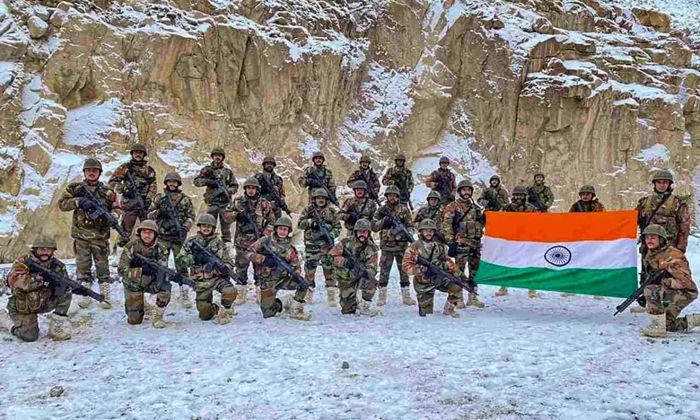IAF airlifted over 68,000 soldiers to eastern Ladakh following Galwan Valley clashes in 2020

New Delhi: Over 68,000 Army soldiers, around 90 tanks and other weapon systems were airlifted by the Indian Air Force to eastern Ladakh from across the country for rapid deployment along the Line of Actual Control (LAC) after the deadly clashes in the Galwan Valley, top sources in defence and security establishment said. The IAF deployed its Su-30 MKI and Jaguar jets for round-the-clock surveillance and intelligence gathering on the enemy build-up, besides putting several squadrons of combat aircraft in “offensive posturing” following the clashes on June 15, 2020 that marked the most serious military conflict between the two sides in decades, they said. The troops and weapons were ferried by the transport fleet of the IAF within a “very short period of time” for quick deployment in various inhospitable areas along the LAC under a special operation, the sources said while highlighting how the force’s strategic airlift capability has increased over the years. In view of the escalating tensions, the IAF had also deployed a sizeable number of remotely piloted aircraft (RPAs) in the region to keep a hawk-eye vigil on Chinese activities, they said. As the lingering border row continues in several friction points, the Indian Army and the IAF have been maintaining a high degree of combat readiness to confront any challenge from the adversary, the sources said. The IAF aircraft airlifted multiple divisions of the Indian Army, totalling over 68,000 troops, more than 90 tanks, nearly 330 BMP infantry combat vehicles, radar systems, artillery guns and many other equipment after the Galwan clashes, they said. The total load carried by the transport fleet of the IAF, which included C-130J Super Hercules and C-17 Globemaster aircraft, was 9,000 tonnes and displayed the IAF’s increasing strategic airlift capabilities, they added. A number of fighter jets, including Rafale and Mig-29 aircraft, were deployed for combat air patrol while various helicopters of the IAF were pressed into service for the transport of prefabricated structures, ammunition and spares of military equipment to mountainous bases. The sources said the range of surveillance by Su-30 MKI and Jaguar fighter jets was around 50 km and they ensured that the positions and movements of Chinese troops were accurately monitored. The IAF also quickly enhanced its air defence capabilities and combat readiness by installing various radars and bringing a range of surface-to-air guided weapons to frontline bases along the LAC in the region, they said. The strategy was to strengthen military posture, maintain credible forces and monitor the enemy build-up to effectively deal with any situation, the sources said, referring to India’s overall approach. The IAF platforms operated in extremely difficult circumstances and accomplished all their mission goals, said a source without sharing further details. The overall operation demonstrated the IAF’s growing airlift capability compared to what it was during ‘Operation Parakram’, said another source. Following the terrorist attack on Parliament in December 2001, India had launched ‘Operation Parakram’ under which it mobilised a huge number of troops along the Line of Control. The government has been giving a major push to infrastructure development along the nearly 3,500 km long LAC following the eastern Ladakh faceoff. The defence ministry has already initiated work on enhancing the overall infrastructure at the Nyoma Advanced Landing Ground (ALG) in eastern Ladakh so that all kinds of military aircraft can operate from it. The Army has also taken a series of measures since the Galwan Valley clashes to enhance its combat capabilities. It has already deployed a significant number of easily transportable M-777 ultra-light howitzers in mountainous regions along the LAC in Arunachal Pradesh. The M-777 can be transported quickly in Chinook helicopters and the Army now has the flexibility of quickly moving them from one place to another based on operational requirements. The Army has powered its units in Arunachal Pradesh with a sizeable number of US-manufactured all-terrain vehicles, 7.62MM Negev Light Machine Guns from Israel and various other lethal weapons. The Indian and Chinese troops are still locked in the over three-year confrontation in certain friction points in eastern Ladakh even as the two sides completed disengagement from several areas following extensive diplomatic and military talks. The ties between India and China nosedived significantly following the fierce confrontation in the Galwan Valley. Each side currently has around 50,000 to 60,000 troops along the LAC in the region. A fresh round of high-level military talks between the two sides is scheduled to take place on Monday. In the dialogue, India is set to press for early disengagement of troops from the remaining friction points. On July 24, National Security Advisor Ajit Doval met top Chinese diplomat Wang Yi on the sidelines of a meeting of the five-nation grouping BRICS in Johannesburg. In its statement on the meeting, the Ministry of External Affairs said Doval conveyed that the situation along the LAC in the western sector of the India-China boundary since 2020 had “eroded strategic trust” and the public and political basis of the relationship. It said the NSA emphasised the importance of continuing efforts to fully resolve the situation and restore peace and tranquility in the border areas so as to remove impediments to normalcy in bilateral ties. The eastern Ladakh border standoff erupted on May 5, 2020, following a violent clash in the Pangong Lake area. (PTI)
